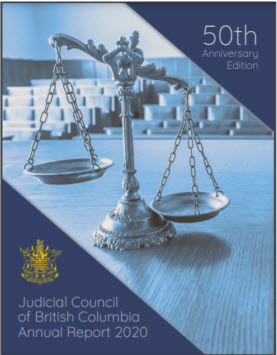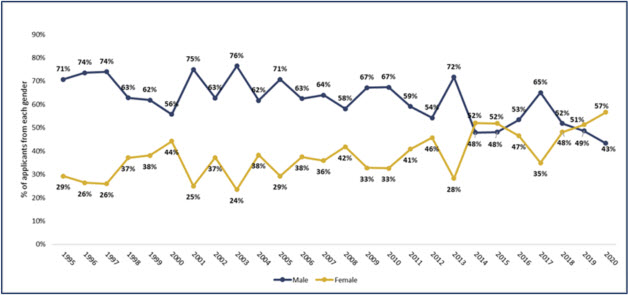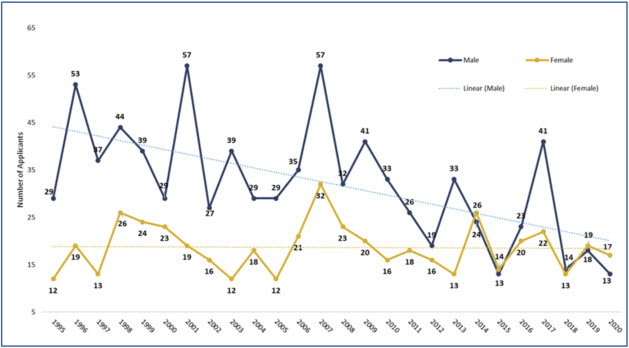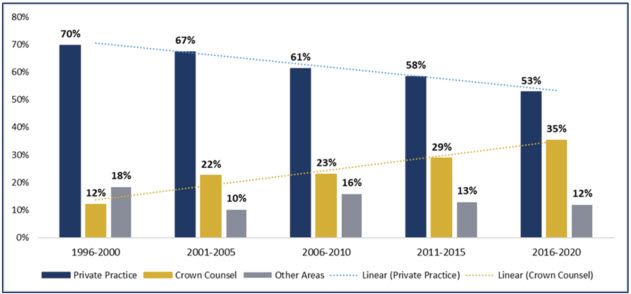BC Judicial Council’s 2020 Annual Report raises fascinating questions. Praised for their transparency, since 1999 the Council’s annual reports have included statistics and demographic information about applicants for appointment as Provincial Court judges and judicial justices. Its recently published 24th report carries on that tradition, providing 2020 statistics and explaining how the Council functioned during the pandemic.
But 2020 marked the Council’s 50th anniversary, and the Report celebrates that milestone by including highlights of its activities over the last five decades, as well as an analysis of trends in applicants’ demographics during the periods for which data is available – around 25 years. And those trends revealed some surprises!
What is BC’s Judicial Council?

The Judicial Council of British Columbia is composed of lay persons, lawyers, and judges. Four of its nine members are appointed by the Lieutenant Governor in Council (the provincial Cabinet). Current appointees include people with policing, business, human resources, and court administration experience. The other members, designated by the Provincial Court Act, are the Chief Judge, an Associate Chief Judge, the president of the Provincial Court Judges’ Association of BC, and two lawyers - the presidents (or their nominees) of the Law Society of BC and the Canadian Bar Association, BC Branch.
When the BC Provincial Court was created in 1969, the Judicial Council was established to keep judges at arm’s length from government. It held its first meeting on August 10, 1970. The Council was given responsibility for screening candidates for appointment, and by 1975 legislation - unique in Canada at the time - said the provincial government could only appoint a judge if they were recommended by the Judicial Council.
The Council’s other responsibilities include:
- overseeing the delivery of education for judicial officers
- maintaining a judicial Code of Ethics
- considering proposals for improving the Court’s judicial services
- undertaking inquiries into the conduct of judicial officers when necessary
Long term trends in applications for appointment
In the last 25 years, BC’s Judicial Council has received an average of 51 applications a year for appointment as a judge and a total of 1,318 applications.
The analysis of long-term trends in the Council’s 50th Anniversary Report includes interesting data on the gender and practice experience of applicants for appointment as a judge.
Regarding applicants’ gender, as this graph shows, the percentage of female applicants for appointment each year since 1995 has increased.

However, that’s not due to an increase in the number of women applying. As shown in this graph, the average number of female applicants per year has been relatively consistent.

What’s the explanation? The average number of male applicants has decreased. It would be interesting to know the reasons for this, and whether other courts have experienced similar trends.
As for applicants’ experience working as lawyers, during the last 25 years, on average, 62% of judicial applicants' experience was in private practice, 24% as Crown counsel, and 14% from other areas of legal practice.
But as this graph shows, the percentage of applicants from private practice has declined over time while the percentage of Crown counsel has increased.

But the increase in the percentage of Crown applicants doesn’t result from an increase in the number of Crown counsel applying. It results largely from a decrease over time in the number of applicants coming from private practice. Again, it would be interesting to know the reasons for this decrease, and whether other courts have experienced similar trends.
Report’s other highlights
The report also contains highlights of the Council’s 50 years of dedication to ensuring exceptional judicial service by the Provincial Court of British Columbia. A decade-by-decade timeline provides ample evidence of the BC Judicial Council’s stature as a Canadian leader in its field. It includes not just the establishment of an independent appointment process in the 1970s, but:
- adoption of a judicial Code of Ethics in 1976, making the BC Provincial Court the first in Canada to have one
- a progressive approach to judicial education, encouraging initiatives by the Court’s judges to use adult education techniques and introduce social context and diversity programs to Canadian judicial education in the 1980s
- a commitment to transparency and accountability, through publication of annual reports since 1996, and applicants’ demographic information since 1999
- ongoing efforts to encourage diverse applicants to seek appointment to the Court
- adoption of online application forms in 2017, creating the first judicial application process in Canada to replace all paper forms and documents
In addition to historical information, the 2020 report reveals how the Council continued its work during the COVID-19 pandemic. It also contains some interesting photographs – including group photos of Councils since 2009 and casual photos of current Council members.

Associate Chief Judge Susan Wishart, Alternate Presiding Member, Judicial Council of BC
Read the Judicial Council of British Columbia’s Annual Report 2020.

